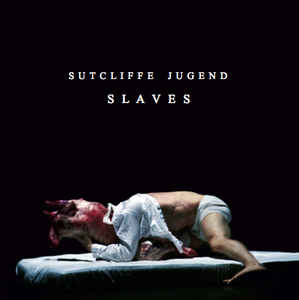 Kevin Tomkins and Paul Taylor’s legendary Sutcliffe Jugend project has alternated between periods of being extremely prolific, followed by utter silence ever since its inception. Their first albums as SJ appeared in 1982, one of which was the legendary 10 tape We Spit On Their Graves, then no new material for 14 years. The pattern has repeated ever since, though admittedly not to the same extremity. S L A V E S, a six CD release, capped off a busy 2016, preceded by three other full length albums. Sprawling is an appropriate term, but it is very well developed, varied, and also makes clear that Tomkins and Taylor have no intent of staying in that narrow box most associate with the project.
Kevin Tomkins and Paul Taylor’s legendary Sutcliffe Jugend project has alternated between periods of being extremely prolific, followed by utter silence ever since its inception. Their first albums as SJ appeared in 1982, one of which was the legendary 10 tape We Spit On Their Graves, then no new material for 14 years. The pattern has repeated ever since, though admittedly not to the same extremity. S L A V E S, a six CD release, capped off a busy 2016, preceded by three other full length albums. Sprawling is an appropriate term, but it is very well developed, varied, and also makes clear that Tomkins and Taylor have no intent of staying in that narrow box most associate with the project.
SJ are one of those "old guard" power electronics projects that have been always associated with the genre, as well as its clichés.Of those early bands (and I am thinking of Whitehouse, Ramleh, Consumer Electronics, etc.), SJ were always the largest purveyors of the psycho-sexual violence aspect of the scene.Unlike many of their followers, it was always something they did very well, but it was also very much a polarizing facet of their work.
Neither that, nor the project's penchant for brutal walls of harsh noise are prominent on S L A V E S, however.While there are undoubtedly harsh moments to be heard across these six discs, usually in the form of distorted guitar squall or processed electronics, the duo always place them tastefully within the other elements.Sonically it is perhaps most akin to 2012's Blue Rabbit, without the paraphillac violent lyrical content, and a smattering of Tomkins and Taylor’s solo projects, which have been in general more freeform and experimental.Given that most of this set is based on studio improvisations (culled from sessions dating back to 2012, that freeform approach shines through.
S L A V E S is conceived as the soundtrack to a non-existent theatre project, with each disc representing a different movement, and the sounds on the album roughly corresponding with that.For example, the most traditionally SJ sounding material is largely present on the first disc, Theatre of Cruelty.The opening piece "With a Cold Heart" leads off with strings and grandiose gothic drama, it sets the mood for the remainder of the disc, punctuated with processed guitar and piano.The subsequent "Woe Betide" is the only moment where Tomkins’ vocals are obvious, in the form of a disconnected randomized mantra of "Description/Destruction/Instruction/Inscription" as pulsating guitars surround.Much of the background is noise, but in a less than harsh approach to come across more as ugly rather than violent.
Theatre of Tragedy (Disc 5) is also one of the more dissonant discs, with a different mood."Her Blood in My Veins" has Taylor and Tomkins leaning into harsher noise territory with its careful feedback and sustained drone, but never to the extent of their previous works.While "Found in Dark Minds" is mostly gentle guitar and string accents, the two blend in their trademark guitar squall tastefully in the background.The scattershot shards of noise heard on "A Life Yet Lived" mixed with what may be heavily processed voice drifts more into conventionally dark ambient, and the closer "Crushed Until Breathless" has a surprising warmth despite its title and pervading bleakness.
The other discs follow similar patterns, but the mood seems less consistent throughout.For example, the broken musical structure and synth heavy sound of "Evolving Sores" on Theatre of the Absurd is not that far removed from vintage Dome, while "Pipe Machine Crooner" on the same album is rumbling and rhythmic static, with added shards of noise, resulting in a skeletal, almost clinically clean approach to power electronics.Then on Theatre of Innocence, "The Golden Age of Innocence (Part 4)" is all heavy thuds and wet, harsh electronics, while the previous part is gentle bowed strings and a lush, almost nautical buoyancy.
At nearly six hours of material, Sutcliffe Jugend's S L A V E S is a lot to take in, even considering it is not as riddled with the harshness and violence (sonically or lyrically) of much of their other work.However, its diversity, and focus on improvisation is its greatest strengths.I found this unpredictable variation a major asset, and what places it amongst their strongest works in their 35 year career.While I do think trying to take it all in on one marathon listening session would be a bit masochistic, approaching it as conceptually intended (as a lengthy work with distinct segments) made it a unique and fascinating suite of sounds.
samples:
 
Read More

